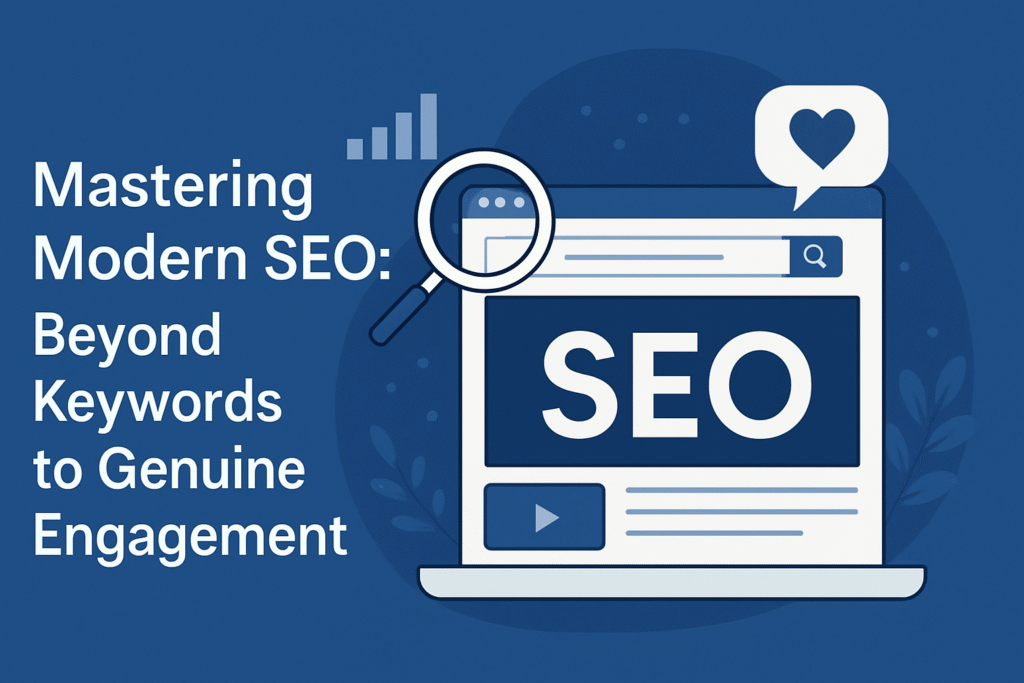The Evolution of SEO: Why “Content Is King” Isn’t Enough Anymore
In the early days of Google, SEO was a technical game of keyword stuffing and backlink schemes. Today, it’s a sophisticated dance between user experience, technical precision, and authentic value. With machine learning algorithms evaluating 200+ ranking factors, your strategy must balance three pillars:
- Content humans love
- Technical foundations bots understand
- Lightning-fast experiences that retain users
Google’s mission is simple: “Show the best answer to every query.” If your content doesn’t satisfy real people, no amount of technical wizardry will save it.
The 4 Non-Negotiable Rules of Modern SEO
1. Create Obsession-Worthy Content (Twice!)
- Solve urgent problems: Identify your audience’s pain points (e.g., “How do I fix slow page loads?” not just “SEO tips”).
- Hook immediately: Use GIFs, stats, or provocative questions in the first 3 seconds to prevent bounces.
Optimize for engagement signals:
- Target dwell time (aim for 2+ minutes)
- Boost pages per session through internal linking
- Reduce bounce rate by delivering on headline promises
📈 Data-backed approach: Tools like Google Keyword Planner help identify high-intent phrases like “how to improve Core Web Vitals” instead of generic “SEO help.”
2. Structure Content for Humans & Bots
Semantic HTML is non-negotiable:
- Wrap articles in
<article>tags with proper schema markup - Use heading hierarchies (H1 > H2 > H3) to outline key concepts
- Add descriptive
alttext to images (critical for accessibility and SEO)
Meta tags that convert:
- Titles under 60 characters with primary keywords near the front
- Descriptions under 155 characters posing a “curiosity gap”
Structured data for rich snippets: Implement schema.org types (Articles, FAQs, How-Tos) to dominate featured snippets.
3. Speed Is a Ranking Superpower
Google prioritizes sites that load in under 2.3 seconds. Optimize through:
- Image compression: Serve WebP/AVIF formats at responsive sizes
- Critical resource prioritization: Lazy-load non-essential JS/CSS
Smart rendering strategies:
- Static Generation (SSG) works best for stable content like blogs and marketing sites. Pages load instantly since they’re pre-built, but require rebuilds for updates.
- Server-Side Rendering (SSR) shines for dynamic content like e-commerce. It serves fresh pages on demand, though may be slightly slower than static options.
- Incremental Static Regeneration (ISR) combines both benefits — pre-rendered pages that update automatically. It’s ideal for frequently changing content while maintaining speed.
The best choice balances your content update needs with performance requirements for optimal SEO results. Most modern sites benefit from hybrid approaches like ISR.
4. Build Authority Through Connections
- Internal linking: Use descriptive anchor text (e.g., “Learn advanced image optimization techniques” not “click here”).
- External linking: Reference authoritative sources (Google trusts sites that curate quality resources).
- Backlink acquisition: Focus on relevance over quantity (1 Forbes link > 100 spammy directory links).
Technical Foundations Most Sites Overlook
XML Sitemaps & Robots.txt:
- Submit sitemaps to Google Search Console
- Block sensitive routes (e.g.,
/admin/) via robots.txt
Core Web Vitals Optimization:
- Eliminate layout shifts (CLS) by sizing images/videos
- Reduce interactivity delay (INP) below 200ms
- Speed up largest contentful paint (LCP) under 2.5s
Mobile-First Essentials:
- Touch-friendly navigation
- Readable fonts (16px minimum)
- Accelerated Mobile Pages (AMP) for media-heavy sites
The Forgotten SEO Power-Ups
- Voice search optimization: Answer questions conversationally (“How do I…”)
- Video SEO: Host transcripts and chapters for YouTube discoverability
- E-E-A-T signals: Showcase author credentials and peer-reviewed sources
- Local SEO: Embed Google Maps and schema for “near me” queries
Your SEO Maintenance Checklist
Daily: Check for crawl errors in Google Search Console to ensure search engines can properly index your pages.
Weekly: Track keyword rankings using tools like SEMrush or Ahrefs to monitor your performance in search results.
Monthly: Audit your backlinks with Moz Link Explorer to maintain a healthy link profile and disavow any spammy links.
Quarterly: Refresh outdated content using Screaming Frog SEO to identify pages needing updates or improvements.
Twice a Year: Run a full technical audit with Lighthouse to catch any speed, accessibility, or SEO issues.
Sticking to this schedule helps catch problems early and keeps your SEO strategy on track.
The Truth About SEO Success
SEO isn’t a one-time project — it’s a continuous conversation with your audience and search engines. The sites dominating rankings in 2024 share three traits:
- They publish 10x content (content 10x better than competitors)
- They iteratively optimize based on performance data
- They treat technical SEO as hygiene, not heroics
🔥 Pro tip: Install analytics before launching. You can’t improve what you don’t measure.
What’s your biggest SEO challenge? Share below — we’ll tackle it in the next guide!


